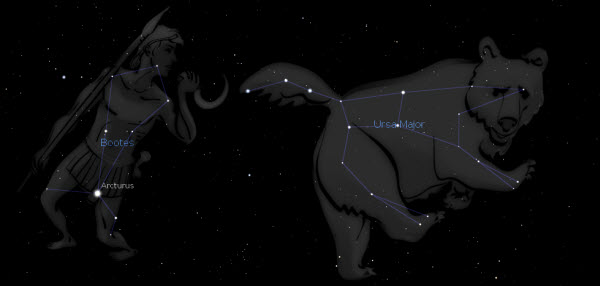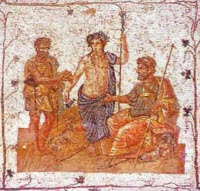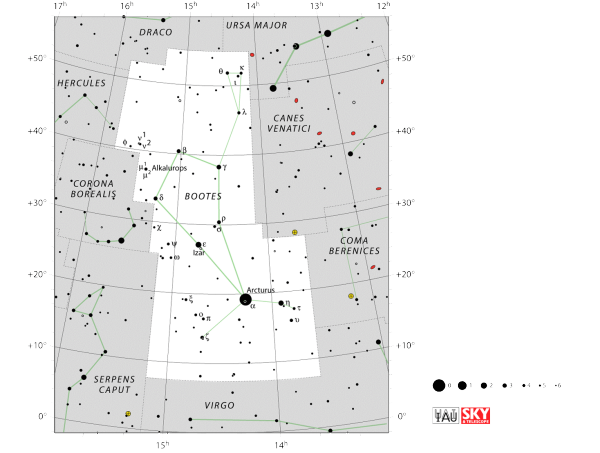The origin of the name Boötes is a little unclear, but may be derived from a Greek word meaning ‘noisy’ or ‘clamorous’, referring to the herdsman’s calling his animals or alternatively from the ancient Greek meaning ‘ox-driver’, from the fact that Ursa Major was sometimes visualized as a cart pulled by oxen.

The Greeks also knew this constellation as Arctophylax, translated as Bear Watcher, Bear Keeper or Bear Guard. In any event this constellation (pronounced Boh-oh-tease) is closely linked in legend with the Great Bear, Ursa Major, because of its position behind the bear’s tail. Later astronomers have given Boötes two dogs, in the form of the neighbouring constellation Canes Venatici but they were not part of the original Greek visualization or legend.
 Another legend identifies Boötes with Icarius, a grape grower who invited the god Dionysus to inspect his vineyards. Dionysus was so impressed he taught Icarius how to cultivate vines and make wine. Icarius produced such good wines that he decided to invite his shepherd friends to try it. Not knowing what they were drinking, they all became very, very intoxicated; suffering from bad hangovers the following day and accused Icarius of trying to poison them, killing him in revenge near his vineyard. Icarius’s dog Maera fled home howling and led Icarius’s daughter Erigone to where the body lay beneath a tree. In despair, Erigone hanged herself from the tree and the dog drowned itself in a nearby stream. (a Greek tragedy if ever there was one) Dionysus was so saddened by the killing of his friend that he placed him in the sky as the constellation Boötes, according to some Erigone and Maera, too, were placed in the heavens as the constellations Virgo and Canis Minor.
Another legend identifies Boötes with Icarius, a grape grower who invited the god Dionysus to inspect his vineyards. Dionysus was so impressed he taught Icarius how to cultivate vines and make wine. Icarius produced such good wines that he decided to invite his shepherd friends to try it. Not knowing what they were drinking, they all became very, very intoxicated; suffering from bad hangovers the following day and accused Icarius of trying to poison them, killing him in revenge near his vineyard. Icarius’s dog Maera fled home howling and led Icarius’s daughter Erigone to where the body lay beneath a tree. In despair, Erigone hanged herself from the tree and the dog drowned itself in a nearby stream. (a Greek tragedy if ever there was one) Dionysus was so saddened by the killing of his friend that he placed him in the sky as the constellation Boötes, according to some Erigone and Maera, too, were placed in the heavens as the constellations Virgo and Canis Minor.
The Constellation
Arcturus (Alpha Boötis) meaning means ‘bear guard’ is a red giant (K1.5 IIIpe) located about 37 light years away. It is the 4th brightest star in the night sky overall with an apparent magnitude of -0.04. It is approximately 28 times bigger than our sun around 25 million miles in diameter, 1.5 times more massive, and at least 110 times more luminous. The star’s location on the celestial equator also makes it easy to spot from both hemispheres, and from northern locations can be found by following the arc of the Big Dipper’s handle away from asterism’s “bowl”.
Arcturus is believed to a member of the 52-strong Arcturus Stream, a small group of stars that is moving perpendicularly through the plane of the Milky Way. Indeed Arcturus is moving through space pretty rapidly relatively to us, (proper motion) Half a million years ago Arcturus was just about visible to the naked eye, our paths since then has brought Arcturus to a position of prominence in the night sky, so that it is now at its brightest. Arcturus will continue to move the Moon’s diameter every two millennia until half a million years hence it will once again be just another stellar face in the firmament. Arcturus is also a member of the Local Fluff, or more precisely, the Local Interstellar Cloud, a 30-light-year-diameter interstellar cloud through which the entire solar system is currently moving.

Arcturus has been studied extensively, being the nearest orange giant star to ourselves, and even been able to measure the amount of heat we receive from it; equivalent to that emitted from a single plumbers candle placed around 5 miles away!
Izar (Epsilon Boötis), the second brightest star in Boötes (magnitude of 2.37), is a binary star found 300 light years away. Its primary component is an orange giant, while its smaller companion is a faint blue-green colored star.
Muphrid (Eta Boötis), the constellation’s third brightest star (magnitude 2.68), is a yellow-white subdwarf located 37 light years away. It is approximately 3 times the size of our sun, 1.5 times more massive, and 9 times brighter.
Nekkar (Beta Boötis) is a yellow giant (G8 IIIa) star located about 220 light years away from Earth. Nekkar is a flare type variable star, and can brighten dramatically in the space of just a few minutes. It is at around 250 million years old, at least 21 times bigger than the Sun, and anything between 170 and 195 times as luminous, depending on its state of variability at any given time.
Seginus (Gamma Boötis) is located about 85 light years away, and is classified as a Delta Scuti variable star with an A7III classification. Delta Scuti variable stars show only marginal variations in brightness, and in the case of Seginus, its magnitude variations of between 3.02 and 3.07 are the result of both rotational and non-rotational pulsations that occur on its surface with a period of only 6.79 hours.
- Log in to post comments
